Nosferatu
| Nosferatu | |
|---|---|
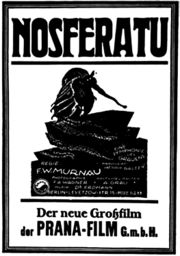 A promotional film poster |
|
| Directed by | F. W. Murnau |
| Produced by | Enrico Dieckmann Albin Grau |
| Written by | Novel: Bram Stoker Screenplay: Henrik Galeen |
| Starring | Max Schreck Gustav von Wangenheim Greta Schröder Alexander Granach Ruth Landshoff |
| Cinematography | Fritz Arno Wagner Günther Krampf |
| Distributed by | Film Arts Guild |
| Release date(s) | Germany: 4 March 1922 USA: 3 June 1929 |
| Running time | 94 min. |
| Country | Germany |
| Language | Silent film German intertitles |
Nosferatu, eine Symphonie des Grauens (translated as Nosferatu: A Symphony of Horror; also known as Nosferatu: A Symphony of Terror or simply Nosferatu) is a German Expressionist horror film, directed by F. W. Murnau, starring Max Schreck as the vampire Count Orlok. The film, shot in 1921 and released in 1922, was in essence an unauthorized adaptation of Bram Stoker's Dracula, with names and other details changed because the studio could not obtain the rights to the novel (for instance, "vampire" became "Nosferatu" and "Count Dracula" became "Count Orlok". At least one English language release features title cards with the actual names from Stoker's novel including "Count Dracula").
Nosferatu was ranked twenty-first in Empire magazine's "The 100 Best Films of World Cinema" in 2010[1]
Contents |
Plot
Thomas Hutter (Jonathan Harker in Stoker's novel) lives in the fictitious German city of Wisborg. His employer, Knock (loosely based on Renfield), sends Hutter to Transylvania to visit a new client named Orlok. Hutter entrusts his loving wife Ellen to his good friend Harding and Harding's sister Ruth, before embarking on his long journey.
Nearing his destination in the Carpathian mountains, Hutter stops at an inn for dinner. The locals become frightened by the mere mention of Orlok's name and discourage him from traveling to his castle at night, warning of a werewolf on the prowl. In his room, Hutter finds a book, The Book of the Vampires, which he peruses before falling asleep.
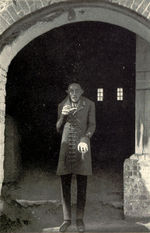
The next morning, Hutter dresses and packs, light-heartedly including the book in his bags. After a coach ride to a high mountain pass, the coachmen decline to take him any further as nightfall is approaching. A sinister black swathed coach of an archaic design suddenly appears and the coachman (obviously Orlock in disguise) gestures for him to climb aboard. Past midnight, Hutter is welcomed at the castle by Count Orlok himself, who excuses the poor welcome as the servants have all gone to bed. While Hutter has a late dinner, Orlok reads a letter. When Hutter cuts his thumb, Orlok tries to suck the blood out of the wound, but his repulsed guest pulls his hand away. Hutter then falls asleep exhausted in the parlor.
He wakes up to an empty castle and notices fresh punctures on his neck, which he attributes to mosquitoes. That night, Orlok signs the documents to purchase the house across from Hutter's own home. Orlok sees Hutter's miniature portrait of his wife and admires her beautiful neck. Reexamining The Book of the Vampires, Hutter starts to suspect that Orlok is Nosferatu, the "Bird of Death". He cowers in his room as midnight approaches, but there is no way to bar the door. The door opens by itself and Orlok enters, his true nature finally revealed. At the same time, Ellen sleepwalks and screams for Hutter. She is somehow heard by Orlok, who leaves Hutter untouched.
The next day, Hutter explores the castle. In its crypt, he finds the coffin in which Orlok is resting dormant. Horrified, he dashes back to his room. From the window, he sees Orlok piling up coffins on a coach and climbing into the last one before the coach departs. Hutter escapes the castle through the window by tieing together strips of the bed linen, but has to jump when his improvised rope runs out, and is knocked unconscious by the fall. He is taken to a hospital. When he is sufficiently recovered, Hutter hurries home.
Meanwhile, the coffins are shipped down river on a raft. They are transferred to a schooner, but not before one is opened by the crew. Inside, they find soil and rats.
Under the long-distance influence of Orlok, Knock starts behaving oddly and is confined to a psychiatric ward. Later, Knock steals a newspaper, which tells of an outbreak of an unknown plague spreading down the coast of the Black Sea. Many people are dying, with odd marks on their necks. Knock rejoices.
The sailors on the ship get sick one by one; soon all but the captain and first mate are dead. Suspecting the truth, the first mate goes below to destroy the coffins. However, Orlok awakens and the horrified sailor jumps into the sea. Unaware of his danger, the captain becomes Orlok's latest victim.
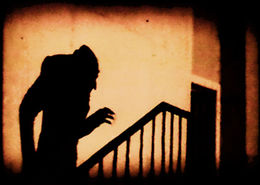
When the ship arrives in Wisborg, Orlok leaves unobserved, carrying one of his coffins. (A passage in The Book of the Vampires reveals that the source of a vampire's power is the soil in which he was buried.) He moves into the house he purchased. The next morning, when the ship is inspected, the captain is found dead. After examining the logbook, the doctors assume they are dealing with the plague. The town is stricken with panic.
Hutter returns home. Ellen reads The Book of Vampires, despite his injunction not to, and learns how to kill a vampire: a woman pure in heart must willingly give her blood to him, so that he loses track of time until the cock's first crowing. There are many deaths in the town. The residents chase Knock, who has escaped after murdering the warden, mistaking him for a vampire.
Orlok stares from his window at the sleeping Ellen. She opens her window to invite him in, but faints. When Hutter revives her, she sends him to fetch Professor Bulwer. After he leaves, Orlok comes in. He becomes so engrossed drinking her blood, he forgets about the coming day. A rooster crows and Orlok vanishes in a bit of smoke as he tries to flee (marking the first death by sunlight in the history of vampire fiction). Ellen lives just long enough to be embraced by her grief-stricken husband. The last image of the movie is of Orlok's ruined castle in the Carpathian Mountains.
Cast
- Max Schreck as Count Orlok (Count Dracula)
- Alexander Granach as Knock (Renfield)
- Gustav von Wangenheim as Thomas Hutter (Jonathan Harker)
- Greta Schröder as Ellen Hutter (Mina Harker)
- Georg H. Schnell as Mr. Harding (Arthur Holmwood)
- Ruth Landshoff as Ruth Harding (Lucy Westenra)
- John Gottowt as Prof. Bulwer (Prof. Van Helsing)
- Gustav Botz as Dr. Sievers (Dr John Seward in Bram Stoker's Dracula)
- Max Nemetz as The Captain of The Demeter
- Wolfgang Heinz as First Mate of The Demeter
- Heinrich Witte as guard in asylum
- Guido Herzfeld as innkeeper
- Karl Etlinger as student with Bulwer
- Hardy von Francois as hospital doctor
- Fanny Schreck as hospital nurse
Origin and publication history
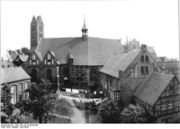
Screenplay and pre-production
Nosferatu was the first and only production of Prana Film,[2] founded in 1921 by Enrico Dieckmann and Albin Grau. Grau had the idea to shoot a vampire film; the inspiration arose from Grau's war experience: in the winter of 1916, a Serbian farmer told him that his father was a vampire and one of the Undead.[3]
Diekmann and Grau gave Henrik Galeen the task to write a screenplay inspired from Bram Stoker's 1897 novel Dracula, despite Prana Film not having obtained the film rights. Galeen was an experienced specialist in Dark romanticism; he had already worked on Der Student von Prag (The Student of Prague) in 1913, and the screenplay for Der Golem, wie er in die Welt kam (The Golem: How He Came into the World) (1920). Galeen set the story in a fictional north German harbour town named Wisborg and changed the character names. He added the idea of the vampire bringing the plague to Wisborg via rats on the ship. He left out the Van Helsing vampire hunter character. Galeen's Expressionist style[4] screenplay was poetically rhythmic, without being so dismembered as other books influenced by literary Expressionism, such as those by Carl Mayer. Lotte Eisner described Galeen's screenplay as "voll Poesie, voll Rhythmus" ("full of poetry, full of rhythm").[5]
Production
Filming began in July 1921, with exterior shots in Wismar.[6] A take from Marienkirche's tower over Wismar marketplace with the Wasserkunst Wismar served as the establishing shot for the Wisborg scene. Other locations were the Wassertor, the Heiligen-Geist-Kirche yard and the harbour. In Lübeck, the abandoned Salzspeicher served as Nosferatu's new Wisborg house. Further exterior shots followed in Lauenburg,[6] Rostock[6] and on Sylt. The film team travelled to the Carpathian Mountains, where Orava Castle[6] served as backdrop for Orlok's half-ruined castle. Nearby locations also served: Hutter's stay at Dolný Kubín;[6] the river journey with the coffins filmed on the Váh River; and the panoramas of the High Tatras mountain range. The team filmed interior shots at the JOFA studio in Berlin's Johannisthal locality.[6] and further exteriors in the Tegel forest.[6] Parts of the film set in Transylvania were also shot in Slovakia.
For cost reasons, cameraman Fritz Arno Wagner only had one camera available, and therefore there was only one original negative.[7] The director followed Galeen's screenplay carefully, following handwritten instructions on camera positioning, lighting, and related matters.[8] Nevertheless Murnau completely rewrote 12 pages of the script, as Galeen's text was missing from the director's working script.[9] This concerned the last scene of the film, in which Ellen sacrifices herself and the vampire dies in the first rays of the Sun.[10][11] Murnau prepared carefully; there were sketches that were to correspond exactly to each filmed scene, and he used a metronome to control the pace of the acting.[12]
Premiere and theatre distribution
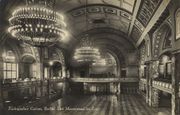
Shortly before the premiere, an advertisement campaign was placed in issue 21 of the magazine Bühne und Film, with a summary, scene and work photographs, production reports and essays including a treatment on vampirism by Albin Grau.[13] Nosferatu's preview premiered on 4 March 1922 in the Marmorsaal of the Berlin Zoological Garden.[6][9] This was planned as a large society evening entitled Das Fest des Nosferatu (Festival of Nosferatu), and guests were asked to arrive dressed in Biedermeier costume.[9] The cinema premiere itself took place on 15 March 1922 at Berlin's Primus-Palast.[6]
Contemporary critique
The Premiere reviewers generally praised the film with some occasionally complaining that the technically perfect and brightly-lit images detracted from the unworldly horror theme.[14] Der Film, a Berlin film magazine, praised the technical quality and the believability of Schreck's portrayal of the vampire, but also felt that his form would have had a greater effect had it been shown more in silhouette.[15]
Deviations from the novel
The story of Nosferatu is similar to that of Dracula and retains the core characters—Jonathan and Mina Harker, the Count, etc.—but omits many of the secondary players, such as Arthur and Quincey, and changes all of the character's names (although in some recent releases of this film, which is now in the public domain in the United States but not in most European states, the written dialog screens have been changed to use the Dracula versions of the names). The setting has been transferred from Britain in the 1890s to Germany in 1838.
In contrast to Dracula, Orlok does not create other vampires, but kills his victims, causing the townfolk to blame the plague, which ravages the city. Also, Orlok must sleep by day, as sunlight would kill him. The ending is also substantially different from that of Dracula. The count is ultimately destroyed at sunrise when the "Mina" character sacrifices herself to him. The town called "Wisborg" in the film is in fact a mix of Wismar and Lübeck.[16]
Influences
This was the first and last Prana Film; the company declared bankruptcy after Bram Stoker's estate, acting for his widow, Florence Stoker, sued for copyright infringement and won. The court ordered all existing prints of Nosferatu destroyed, but copies of the film had already been distributed around the world. These prints were then copied over the years, helping Nosferatu gain its current reputation as one of the greatest movie adaptations of the vampire legend.
With the influence of producer and production designer Albin Grau, the film established one of two main depictions of film vampires. The "Nosferatu-type" is a living corpse with rodent features (especially elongated fingernails and incisors), associated with rats and plague, and neither charming nor erotic but rather totally repugnant. The victims usually die and are not turned into vampires themselves. The more common archetype is the "Dracula-type" (established by Bela Lugosi's version of Dracula and perpetuated by Christopher Lee), a charming aristocrat adept at seduction and whose bite turns his victims into new vampires.
A more universal effect of the film is less obvious: the ending of Nosferatu single-handedly created the concept that vampires can be physically harmed by sunlight. While this was a common element of many other mythical creatures, pre-Nosferatu vampires disliked but could endure daylight (for instance, a part in the original Dracula novel shows its count in a London street by day). Since Nosferatu's release, the vampire legends have quickly incorporated the idea of fearing, or being destroyed by, the sun.
Murnau's Nosferatu is in the public domain in the United States but not in Germany, and copies of the movie are widely available on video (usually as poorly transferred, faded, scratched video copies that are often scorned by enthusiasts). However, pristine restored editions of the film have also been made available, and are also readily accessible to the public.
The movie has received not only a strong cult following, but also has received overwhelmingly positive reviews, including being cited as the best of all the adaptations of Dracula. On Rottentomatoes.com it received a "Certified Fresh" label and holds a 98 percent "fresh" rating based on 46 reviews.
Derivative works
Aaron Copland's 1922 ballet Grohg (unpublished and unpremiered until 1992) used Nosferatu as the physical model for the lead character and roughly follows the storyline.
Werner Herzog's 1979 homage to Nosferatu, Nosferatu the Vampyre starred Klaus Kinski as Count Dracula, not Orlok. A sequel to Herzog's film called Vampire in Venice starred Kinski, this time as Nosferatu, and Christopher Plummer as Paris Catalano. The 1979 television movie Salem's Lot modeled the appearance of Mr. Barlow on that of Count Orlok. In 1998, Wayne Keeley wrote and directed Nosferatu: The First Vampire, in which the original film was remastered to a soundtrack by Type O Negative and hosted by David Carradine. A 2000 Hollywood movie called Shadow of the Vampire told a secret history of the making of Nosferatu, imagining that actor Max Schreck (played by Willem Dafoe) was actually a genuine vampire, and that director F. W. Murnau (John Malkovich) was complicit in hiring the creature for the purpose of realism.
See also
- Dana Gioia
- List of films in the public domain in the United States
- List of German films 1919–1933
- Nosferatu the Vampyre, Werner Herzog's 1979 remake
Notes
- ↑ "The 100 Best Films of World Cinema". Empire. http://www.empireonline.com/features/100-greatest-world-cinema-films/default.asp?film=21.
- ↑ ChiaroScuro quoting Thomas Elsaesser
- ↑ Christiane Mückenberger; Günther Dahlke; Günter Karl (Hrsg.) (1993), "Nosferatu" (in German), Deutsche Spielfilme von den Anfängen bis 1933, Berlin: Henschel Verlag, pp. 71, ISBN 3-89487-009-5
- ↑ Roger Manvell, Henrik Galeen - Films as writer:, Other films:, Film Reference, http://www.filmreference.com/Writers-and-Production-Artists-Ei-Gi/Galeen-Henrik.html, retrieved 2009-04-23
- ↑ Eisner 1967, page 27
- ↑ 6.0 6.1 6.2 6.3 6.4 6.5 6.6 6.7 6.8 ChiaroScuro
- ↑ Prinzler page 222: Luciano Berriatúa and Camille Blot in section: Zur Überlieferung der Filme. Then it was usual to use at least two cameras in parallel to maximise the number of copies for distribution. One negative would serve for local use and another for foreign distribution.
- ↑ Editors of German Wikipedia citing Eisner 1967 page 27
- ↑ 9.0 9.1 9.2 Editors of German Wikipedia
- ↑ Editors of German Wikipedia citing Eisner 1967 page 28 Since vampires dying in daylight appears neither in Stoker's work nor in Galeen's script, this concept has been solely attributed to Murnau.
- ↑ Michael Koller (July 2000), "Nosferatu", Issue 8, July–Aug 2000 (senses of cinema), http://archive.sensesofcinema.com/contents/cteq/00/8/nosferatu.html, retrieved 2009-04-23
- ↑ Editors of German Wikipedia citing Grafe page 117
- ↑ Editors of German Wikipedia citing Eisner page 60
- ↑ Prinzler p. 131. Bilder ... sehr schön, sehr klar, sehr scharf. Jedoch: Was bei anderen, wirklichkeitstreuen Filmen ein Vorteil ist, muß bei einem Werk aus der Unwirklichkeit gegenteilig bewertet werden.
- ↑ filmhistoriker.de (Berlin) vol. 7, no. 11, 12 Mar 1922, p. 45
- ↑ Ashbury, Roy (2001-11-05), Nosferatu (1st ed.), Pearson Education, pp. 41
References
- Lotte H. Eisner; Hilmar Hofmanns; Walter Schobert (1980) (in German), Die dämonische Leinwand, Frankfurt am Main: Fischer Taschenbuch Verlag, ISBN 3-596-23660-6
- Lotte H. Eisner (1967) (in German), Murnau. Der Klassiker des deutschen Films, Velber/Hannover: Friedrich Verlag
- Frieda Grafe; Enno Patalas (2003) (in German), Licht aus Berlin. Lang Lubitsch Murnau, Berlin: Verlag Brinkmann & Bose, ISBN 9783922660811, ISBN 3-922660-81-9
- Hans Helmut Prinzler, ed. (2003), "Nosferatu" (in German), Friedrich Wilhelm Murnau : ein Melancholiker des Films, Berlin: Bertz Verlag GbR, ISBN 3-929470-25-X
- "Nosferatu - a Filmarcheology", ChiaroScuro/CeltoSlavica (Markus Osterrieder), http://www.celtoslavica.de/chiaroscuro/vergleiche/nos.html, retrieved 2009-04-23 - details of versions, intertitles and restoration
- Brill, Olaf (in German), Film Nosferatu, Eine Symphonie des Grauens (GER 1922), http://www.filmhistoriker.de/films/nosferatu.htm, retrieved 2009-06-11 (1921-1922 reports and reviews)
External links
- Nosferatu available for free download at the Internet Archive [more]
- Nosferatu information at the Internet Movie Database
- Watch Nosferatu online on Jammer Direct.
- Nosferatu cut-report Comparison between Public Domain Version and Restored Version, at Movie-Censorship.com
|
||||||||
|
||||||||||||||||||||||||||||||||||||||||